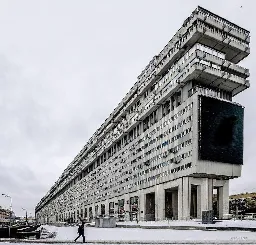Architecture
- Saudi Arabia Discovers It's Hard to Build a 105-Mile Skyscraperfuturism.com Saudi Arabia Discovers It's Hard to Build a 105-Mile Skyscraper
Neom and its enormous skyscraper, the Line, is set to cost trillions more than anticipated and is already mired in construction setbacks.
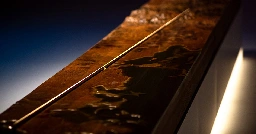
- Inside Frank Lloyd Wright's dream house in Wisconsin.
Inside Frank Lloyd Wright's dream house in Wisconsin.
An interesting piece of modernist architectural history here: https://youtu.be/dE6E7vtEKD4?si=8yw75KKIXEv-Jl3t
Also interested if @philipthalis or any other architects on Mastodon have any thoughts?
- Open-Source Water Purification, Structures, and Sanitation (Off-Grid Communities) 📖💧🏠🚾🌱www.eco-libre.org 2023 Annual Report - Eco-Libre
In 2023, we added 4 new open-source hardware projects to address community's human rights, including access to safe water, shelter, and sanitation

Happy 2024! The Eco-Libre project published our 2023 Annual Report for last year.
[!Eco-Libre 2023 Annual Report](https://www.eco-libre.org/2023-annual-report/)
Eco-Libre is a volunteer-run project that designs libre hardware for sustainable communities.
> Eco-Libre's mission is to research, develop, document, teach, build, and distribute open-source hardware and software that sustainably enfranchises communities' human rights. > > - Eco-Libre's mission statement
We aim to provide clear documentation to build low-cost machines, tools, and infrastructure for people all over the world who wish to live in sustainable communities with others.
Executive Summary
- Eco-Libre was founded June 24, 2023
- Begun searching for land in Ecuador
- Four projects created on GitHub
- Currently 2 active contributors
- 2024 priority is finding land and R&D on Life-Line
Michael Altfield registered the domain-name eco-libre.org on June 24th, 2023, a few weeks after arriving to Ecuador.
Over the next 6 months, Eco-Libre committed research and designs to our GitHub org for four projects (licensed CC BY-SA) which address some of the essential requirements for a new community's basic human needs: clean water, shelter, electricity, and ecological processing of waste. By releasing these designs under a libre license, it allows for other communities to build their own infrastructure with minimal effort, and it encourages collaboration on standardized design concepts.
As Eco-Libre's projects mature, we will build experimental prototypes in our own community. To that end, Michael is currently traveling around Ecuador by bicycle in-search of land to found Eco-Libre's first physical site.
In December, Eco-Libre was joined by Jack Nugent, who has since committed contributions to the Eco-Libre Life-Line project.
The priority focus for Michael in 2024 is to determine the best region in Ecuador to buy land where Eco-Libre can physically iterate on projects.
The priority focus for Jack in 2024 is to finish the research, design, and documentation of the Eco-Libre Life-Line project.
Projects
Eco-Libre was founded this year (in 2023). In our first 6 months, we've begun work on four libre hardware projects. All of them are currently in the early research stages.
Eco-Libre Launch-Nest
The Eco-Libre Launch-Nest was our first project. The concept is to build a small-footprint, high-occupancy structure for sustainable living of 30-people.
| [!CAD screenshot of a 6-story masonry structure with a large array of solar panels and three large parabolic solar dishes on the roof](https://www.eco-libre.org/2023-annual-report/#launch-nest) | |:--:| | Eco-Libre Launch-Nest 2023.09 |
The rooftop has sufficient space for 72 solar panels (2 meter x 1 meter) and 3 parabolic solar concentrators (16 square meter).
The structure is six-stories above-ground, which is the recommended maximum height of a confined masonry structure in an earthquake zone. It also has a basement.
The building is designed with external, enclosed, firewalled staircases on either end. These are symmetrical and designed such that the building design can be rotated around a center courtyard to have four Eco-Libre Launch-Nest structures that share the same stairwells.
Currently only basic, incomplete architectural design-work has been done in CAD. Before a structural analysis can be assessed (eg to determine the location of columns), further work needs to be done on finishing the placement of windows, doors, and dividing walls.
Eco-Libre Life-Line
The Eco-Libre Life-Line project is a series of components making up an infrastructure to deliver a clean water pipeline to a community. This includes:
| [!Photo of a small weir funneling watter into a 200L barrel with an expanded metal grate covering its opening](https://www.eco-libre.org/2023-annual-report/#life-line) | |:--:| | Eco-Libre Life-Line 2023.12 |
- Collection of raw surface water (eg from a stream)
- Removal of large organic debris & sediments
- Removal of small particles
- Removal of harmful bacteria & parasites
- Clean water storage
Michael started the Life-Line project after visiting a number of communities who had constant issues with their water systems breaking or failing to provide clean water. The goal is to design a low-cost, self-cleaning pipeline of systems that require minimal human intervention (max routine maintenance twice per year).
This year we have half-finished the "intake" component in CAD, which consists of building a weir in a stream that funnels turbulent water onto a downward-sloped HDPE barrel with a fine-mesh screen atop it. This design exploits the energy in falling turbulent water to clean the intake screen, and it prevents the intake from being clogged by organic debris during heavy rainfall.
Special thanks to Jack Nugent, who joined Eco-Libre in 2023 and has contributed to research, design, and documentation of the Eco-Libre Life-Line project.
The goal in 2024 is to finish the "intake" component in CAD and also to design the "settling tank", "pre-filter", and "sand filter" components in CAD.
Eco-Libre Genesis-Booth
How do you sustainably begin to build a community on land without electricity and without any structures?
The Eco-Libre Genesis-Booth is a simple storage shed with >1 kW of PV solar panels on the roof. This is the first structure to be built when jumpstarting a new off-grid community. It provides the power, storage, and outdoor workshop space needed to build-out the community.
| [!Photo of a small structure with 4 solar panels on its roof](https://www.eco-libre.org/2023-annual-report/#genesis-booth) | |:--:| | Eco-Libre Genesis-Booth 2023.06 |
This year we've made a simple footprint for the Genesis-Booth in CAD that's 4 meters x 2 meters -- just large enough to fit 4 solar panels (2 meters x 1 meter each). Further work is needed in CAD, but this year we also delved into making a framework for our documentation.
The Eco-Libre documentation is written in reST, generated by Sphinx, and (currently) hosted by GitHub. This is an exceptionally flexible continuous documentation solution that allows for versioned documentation matching versioned releases, works well with git, can be exported to many different flexible formats, and can be extended with custom directives written in python.
The highest priority for the Genesis-Booth is to finish this documentation as a template for other projects. Ideally this should be designed in such a way that information about Eco-Libre in general is seamlessly added to all project's documentations in a reusable way.
Eco-LIbre Treasure Tower
The Eco-Libre Treasure-Tower project is a 7 meter x 6 meter structure for storing and processing a community's waste, most importantly their food & fecal compost.
| [!Photo of a tall 6-story structure with a wrap-around ramp and several doors on each floor](https://www.eco-libre.org/2023-annual-report/#treasure-tower) | |:--:| | Eco-Libre Treasure-Tower 2023.07 |
This structure is 6-stories high and barrier-free, with a wrap-around ramp. All but the top-floor have three doors:
- Access door for maintenance
- Deposit Closet
- Deposit Closet
Each deposit closet contains facilities for the collection of human urine and feces and is slightly staggered in elevation so the user's deposits fall by gravity into their designated collection areas for processing.
Separately from compost, this structure also serves as a storage area for recyclable waste materials, such as metal.
This year a first-draft design of the structure has been designed in CAD, but it's very premature.
Next, a second design prototype (where the two deposit closet entrances are on the same side) should be drafted in CAD and compared to the existing design.
Contribute to Eco-Libre
If you'd like to help Eco-Libre reach our mission to enfranchise sustainable communities' human rights with libre hardware, please contact us to get involved :)
Cheers, The Eco-Libre Team https://www.eco-libre.org/
- Historical Museum of BiH in Sarajevo; built in 1963, architect Boris Magas

Photo was made by myself. Original content under CC-BY-4.0.
- Studio Libeskind creates social housing block for first New York projectwww.dezeen.com Studio Libeskind creates social housing block for first New York project
A sculptural facade defines the Allan & Geraldine Rosenberg Residences, a housing block in Freeport, New York, designed by Studio Libeskind.
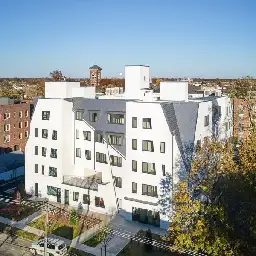
- What Makes Buildings Beautiful (And Why Beauty Does Matter)

YouTube Video
Click to view this content.
In which The Aesthetic City takes a deep dive on why people (especially student and professional architects) tend to like adequately-beautifully, designed buildings in cities and towns over modern-age ones, and some more surprising factoids over tastes and philosophies of some notable modernist architects of today along the way.
- Avala Tower, Belgrade, Serbia

Telecommunication tower built in 1965 according to the project of Uglješa Bogunović, Slobodan Janjić and Milan Krstić. Destroyed in an air raid in 1999, rebuilt according to the original project in 2010. One of the most famous examples of Yugoslavian Brutalism in architecture. A photo of the tower was included in the exhibition "Toward a concrete Utopia: Architecture in Yugoslavia, 1948-1980", organized at the Museum of Modern Art in New York in 2018. This exhibition opened Yugoslavian modernist architecture to the world.
Original content, CC-BY-4.0.
- British Museum Great Court Ceiling

The Great Court is the largest covered public square in Europe. The ceiling is made up of 3312 panels, every panel is a unique shape.
- "50 yars of the USSR", Novokuznetsk, Russia

Built in 1972, architect A. Vipov (А.И. Выпов). Unofficial name is "The Stone Flower".
- Morphogenesis completes world's largest office building in Indiawww.dezeen.com Morphogenesis completes world's largest office building in India
Morphogenesis has unveiled the Surat Diamond Bourse in India, which has surpassed the Pentagon to become the world's largest office building.
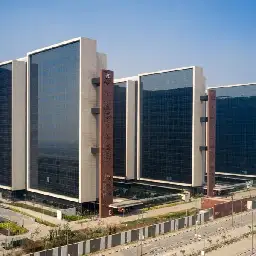
- Museum of Contemporary Art, Belgrade

Built in 1965 according to the design of Ivan Antić and Ivanka Raspopović. According to the design, the building should look like a crystal. It was renovated in 2007-2017. When the renovation began, one of the architects of the original project was still alive and participated in the renovation.
Compared to other examples of Yugoslavian modernism, this building is in very good condition and is well maintained. Also the surrounding area of the park is very human friendly compared to examples of Yugoslavian Brutalism, which looks more like some kind of ghetto.
Near the building there are benches and monuments in the modernist style:
- Genex Tower, Belgrade, Serbia.

Genex Tower (or Western City Gate) is one of the most famous examples of Yugoslavian brutalism architecture. The sky scraper was built in 1979 by architect Mihajlo Mitrović. The left part of the building contained apartments and the right part was suited for offices. In communist era there was the office of "Generalexport" here but today the right side is used as a stand for advertisements.
On the top there was a rotating restaurant here but today it is closed as I know.
Even being in a very bad condition the building still inspires, and you have a lot of controversial feelings when you stay nearby. !
One may say that the building dominates and suppresses surroundings but it is a common for almost all modernist architecture.
- Air Force Command Building, Belgrade, Serbia.

Built in 1935 by architect Dragiša Brašovan. Nice example of socialist modernism architecture of the period between world wars. Compared to after WWII Yuguslavian modernist architecture that was inspired by Le Corbusier, this building looks like more Art Deco style. Especially these window elements: !
On the other side of the building there are statue of Icarus, the work of the sculptor Zlata Markov: !
Entrance group is looking like this today: !
Building was heavily damaged in 1999 and now looks abandoned. More information in wikipedia.
- Hotel Jugoslavija, Belgrade, Serbia.

Built in 1969 by architect Lavoslav Horvat. A nice example of socialist modernism in architecture and Yugoslavian architecture. In communist-era it was used for foreign delegation and diplomats but it is semi-abandoned today and, as I know, is not used as a hotel anymore. More information may be found in wikipedia.
Some additional photos:
- Behind the Accidentally Resilient Design of Athens Apartmentsgetpocket.com Behind the Accidentally Resilient Design of Athens Apartments
Athens polikatoikias—concrete apartments with tiered balconies—were built quickly to create affordable housing, but their design has stood the test of time.
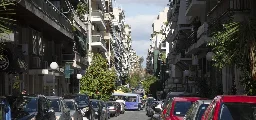
- 25 Perfectly Detailed Floor Plans of Homes from Popular TV Showswww.arch2o.com 25 Perfectly Detailed Floor Plans of Homes from Popular TV Shows - Arch2O.com
Iñaki used pencil colors, cardboard, ink, and markers, instead of interior design software programs, to make this TV shows Floor Plans less technical.

- Habitat Qinghuangdao, Chinawww.archdaily.com Habitat Qinghuangdao / Safdie Architects
Completed in 2017 in Qinhuangdao, China. The design for the Phase I of Qinhuangdao Golden Dream Bay, a high-density beachfront residential community, utilizes a series of stacked vertical...

- Thoughts on apartments with atriums?
It wasn't until I started getting into architecture when I realozed just how many apartments have atriums (atria?) Hotels as well. Now I'm curious about what benefits they have over closed corridors on each floor. I read some things about it being beneficial for passive ventilation, but are there anything else beneficial about them to warrant them being so popular?
What about the drawbacks? Like, wouldn't sound be transmitted pretty easily through it and you'll be able to hear more of your neighbours as well as whatever's going on in the lobby/common area? Also, why not just use the space the atrium takes up to make each unit bigger, or the building footprint smaller?
What are your thoughts on atria? Do you like them? Hate them? Any other benefits and drawbacks I've not thought of?
- "The House of Soviets", designed by Yulian L. Shvartsbreim in Kaliningrad. It was built on top of the pre-Soviet Königsberg Castle, which had been partially destroyed in WWII.
cross-posted from: https://lemmygrad.ml/post/270359
> Sources for pictures and more info here: https://www.archdaily.com/897382/the-house-of-soviets-why-should-this-symbolic-work-of-soviet-brutalism-be-preserved > > This building has a really interesting history but is in danger of being demolished. Definitely worth a read. > > I'm also a fan of walkways between buildings. Especially somewhere where the weather isn't very favourable for large parts of the year, it's both convenient, and more importantly, more accessible for differently abled people. > > ! > > ! > > ! > > ! > > ! > > ! > > ! > > ! > > ! > > ! > > ! > > ! > > ! > > ! > > ! > > ! > > !
- Weird and wonderful Soviet brutalist buildings.
cross-posted from: https://lemmygrad.ml/post/270375
> Got these pictures from an article by a well-known US news outlet. Which literally only mocks the brutalism style and calls it ugly in a very "communism bad" undertone, and adds nothing of value. And they weren't even the creators of these images. So I won't even bother linking it and not give it SEO. > > IDK what they were going on about because all these buildings look amazing. Weird looking yes, but also amazing. > > ! > > ! > > ! > > ! > > ! > > ! > > ! > > ! > > ! > > ! > > ! > > ! > > !
- Urban exploring at Hovrinskaya Hospital, Moscow, Russia.www.christravelblog.com RUSSIA - Hovrinskaya Hospital: Scary urban exploring in Moscow
Hovrinskaya Hospital is the place to go urban exploring in Moscow. It's said to be haunted and dead people are found often. I show you the way to visit!
- Where can I find floor plans?
I've always been really interested in apartment design, especially the structure and layout inside the building that most people don't see from a bird's eye view. To this end, I really enjoy looking at floor plans, especially large ones that show entire floors of an apartment with all the units, corridors, and common spaces. However, when I search for floor plans using the image search function of search engines, most of the results I get are from rental and real estate websites, and Pinterest, the latter of which almost never includes the source of the image. Are there better places for finding floor plans? Especially the whole-floor floor plans I talked about.
- The Architect Who Revived China’s Love for Its Ancient Buildings. In the early 1930s, Liang Sicheng’s now-legendary survey of a centuries-old temple inspired a generation of his peers.www.sixthtone.com The Architect Who Revived China’s Love for Its Ancient Buildings
In the early 1930s, Liang Sicheng’s now-legendary survey of a centuries-old temple inspired a generation of his peers.
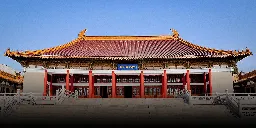
- Upcycle Studios: Townhouses made with recycled materials in Copenhagen, Denmark. Built by Lendager Group.

Official page from Lendager: https://lendager.com/en/architecture/upcycle-studios-en/
This looks like the source for the pictures: https://drwong.live/design/upcycle-studios-townhouses-lendager-group-copenhagen-recycled-materials/
The majority of the results I got from a search were from Pinterest, which was annoying.
- houses carved into the stone in langensteinwww.atlasobscura.com How 19th-Century German Farmers Turned Caves Into Homes
Preserving an unusual slice of rural life.
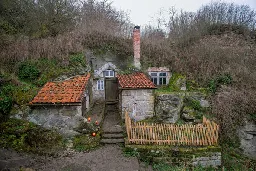
I mean, that's one way of handling a housing shortage, I guess?








